How to create a megatrend radar in 30 minutes

There is little debate over the biggest changes affecting our economy and society today. Megatrends touch upon every business, and thanks to their long-lasting nature, there's not a shortage of readily available information and analysis on them.
However, it's not always clear how to best use this information to your advantage. But what if we told you that you can build a trend radar of megatrends relevant to you in under 30 minutes and use this as a starting point for your own futures intelligence? Read on and we will show you how.
What you need to build your megatrend radar
To follow along with this tutorial, you’ll need:
- A FIBRES account for creating your radar
- A list of previously recognized megatrends
If you haven’t tried FIBRES before, you can start your free 30-day trial right now. You don’t need a credit card to get started and there are absolutely no strings attached.
Step 1: Get your hands on some megatrends
The very first thing you'll want to do is compile a list of megatrends. Luckily, there's no need to go into full research mode here (or otherwise this wouldn't be a 30-minute tutorial).
The internet is full of megatrends listed by renowned futurists and consulting powerhouses. The simple Google search "megatrends + year" or "megatrends + industry" will yield more than enough results. Here are some sources you could look at:
- Peter Fisks's megatrends for 2020-2030
- Sitra 5 megatrends for 2020
- EY Megatrends 2020 and beyond
- PwC Megatrends: 5 global shifts changing the way we live and do business
- MIT's 9 Megatrends That Will Shape the World in 2030
Don't overthink your selection too much at this point. Given that megatrends are, by definition, globally recognized and long-lasting developments, you are unlikely to make a completely "wrong" selection.
For this tutorial, we are using futurist Elina Hiltunen's 10 megatrends for 2020s which includes the following megatrends, also visualized in the infographic below:
- Climate change
- Increase of population
- Demographic change
- Urbanization
- Globalization
- Increase of wealth and consumption
- Inequity
- Ecocrises and resource depletion
- Digitalization
- Development of technology
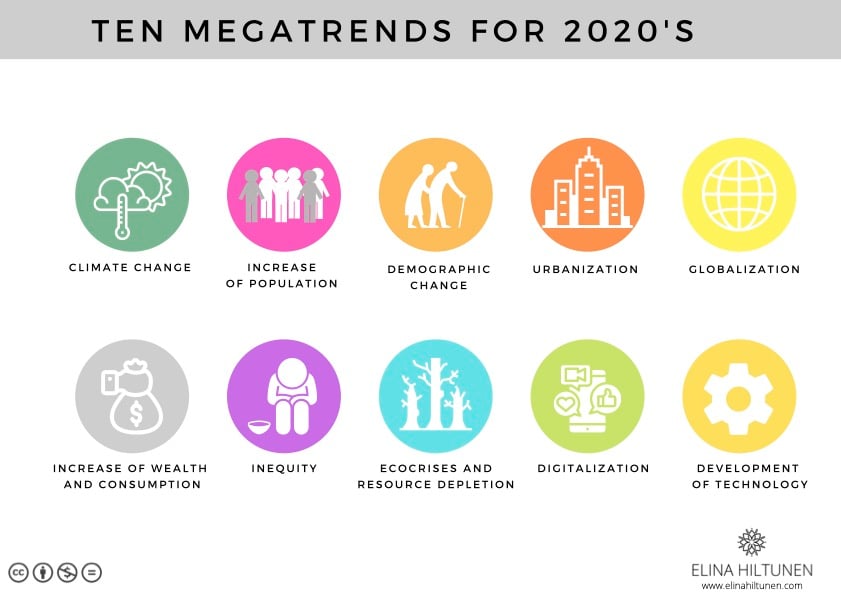
Step 2: Add your megatrends into FIBRES
The next step is to add your megatrends into FIBRES. For each of the megatrends, you'll want to create a separate item in your FIBRES Account.
The workflow for doing this is clicking CREATE, selecting Megatrend for the content type, and giving your Megatrend a title. After the megatrend is created in FIBRES, you can add an image, write a description, or add tags to your megatrend.
So for one of Elina Hiltunen's megatrends, increae of wealth and consumption, the FIBRES Megatrend would look like this:
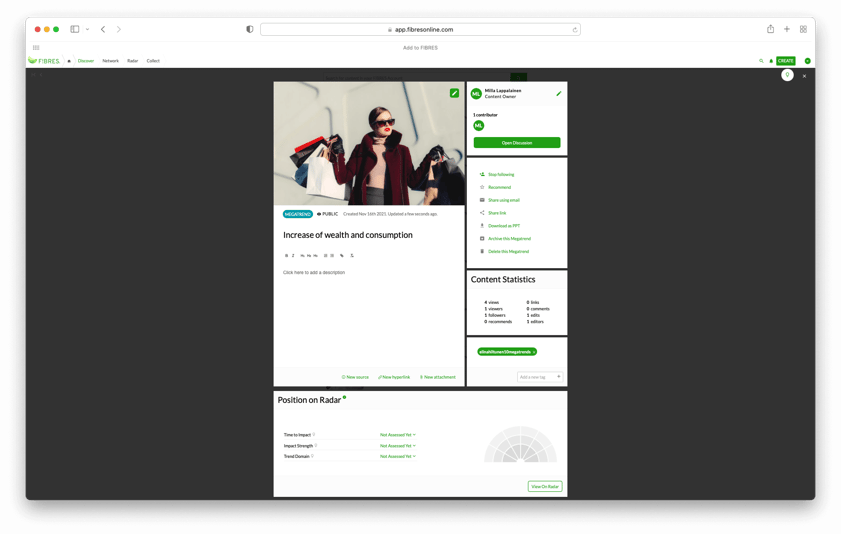 If the megatrends you collected in Step 1 exist in their own URLs (they are separate news articles, for example) the fastest way to add them to FIBRES is by using the FIBRES web clipper. Items added with the Web Clipper are given the content type of a Signal, but you can easily change it to Megatrend afterward.
If the megatrends you collected in Step 1 exist in their own URLs (they are separate news articles, for example) the fastest way to add them to FIBRES is by using the FIBRES web clipper. Items added with the Web Clipper are given the content type of a Signal, but you can easily change it to Megatrend afterward.
After repeating this for all your megatrends, you should have a list of FIBRES Megatrends in your Discover section. If you have a lot of content in your FIBRES already, you can use the sorting option to sort the newest first to get your lately added Megatrends at the top.
Our list of Elina's megatrends looks as follows:
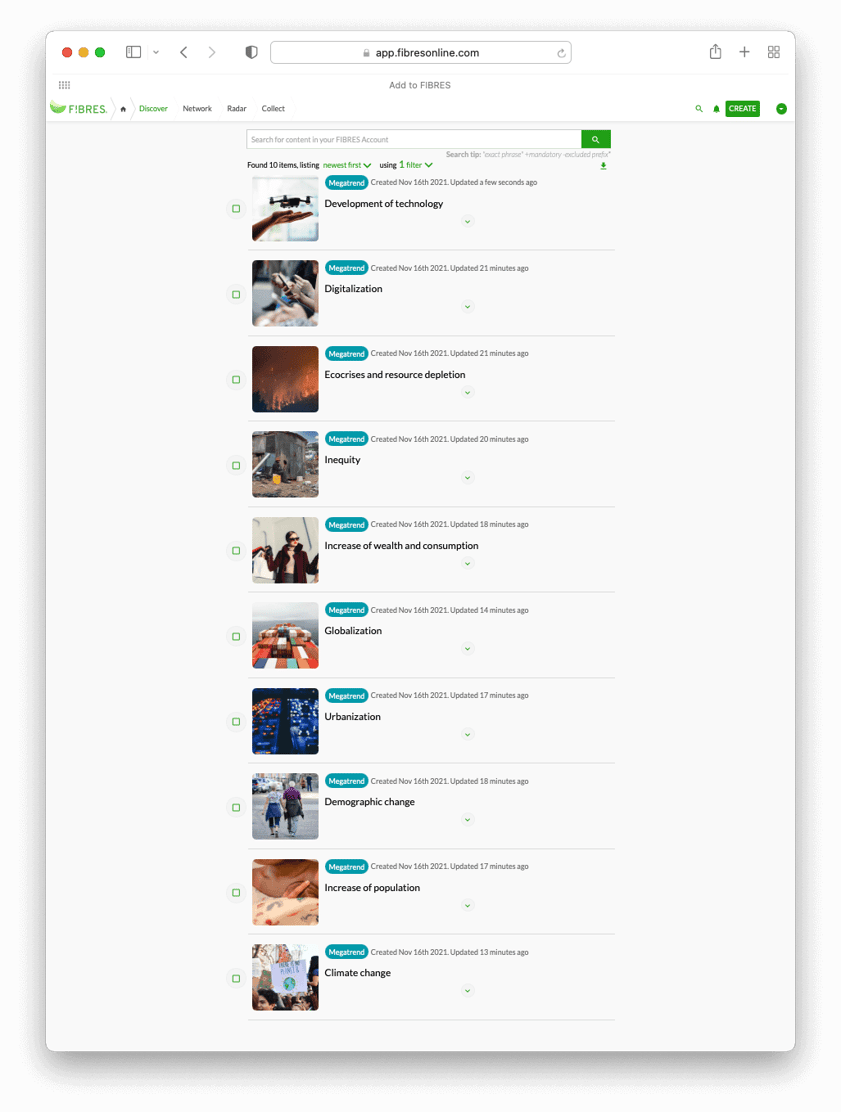
Step 3: Give your megatrends a unique tag
The next step is to give your megatrends a common tag to distinguish them from other content in your FIBRES Account.
To do this, open any of your megatrends and start typing to create a new tag. Then, add the same tag to the other megatrends. We used the tag elinahiltunen10megatrends for our megatrends.
Any view in FIBRES can be filtered with tags, including the Radar view... which leads us to the final step: adding your megatrends to the Radar! Keep your megatrends open as you'll need them in the next step.
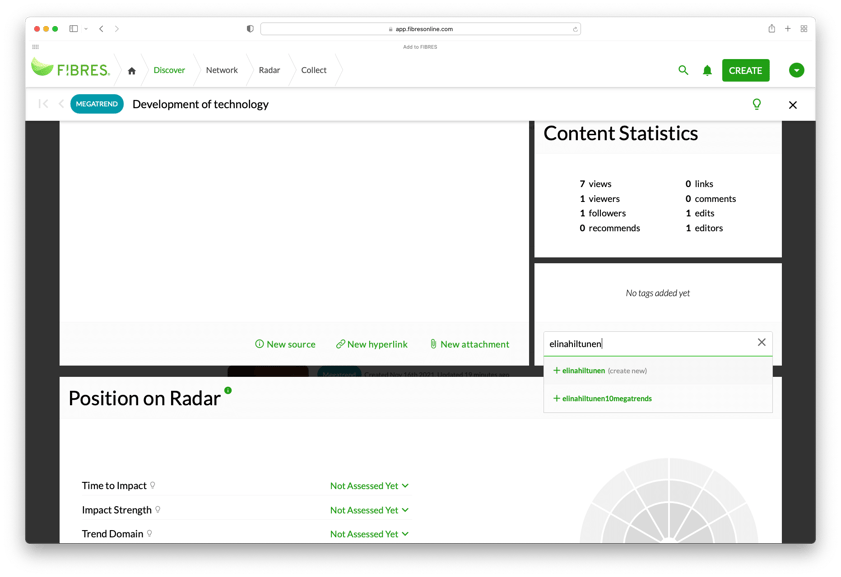
Step 4: Position the megatrends on the Radar
Once you have added all your megatrends into FIBRES and tagged them with a common tag, it's time to populate the Radar.
The Radar is an automated feature of FIBRES that shows content that you've chosen to display on it. It also has the sectors and time axis of your choosing – for this purpose we are using a PESTEL Radar.
Adding new content to the Radar is as simple as it gets. Inside each of your megatrends, scroll down to Position on Radar. Choose a value from each of the dropdowns, and your megatrend will pop up on the Radar.
Deciding where to place items is not always self-evident. If you are working with a PESTEL Radar like we are in this tutorial, it's useful to think about where the megatrend originates from.
For example, Elina Hiltunen's megatrend for Ecocrises and resource depletion would quite naturally be placed in the Ecological sector of the PESTEL Radar. However, since you are compiling the trend radar for your purposes, it is your own evaluation that matters most.
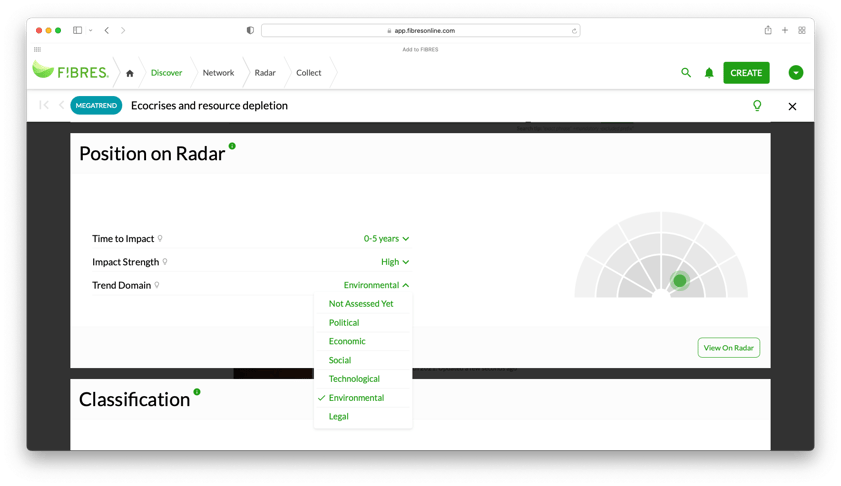
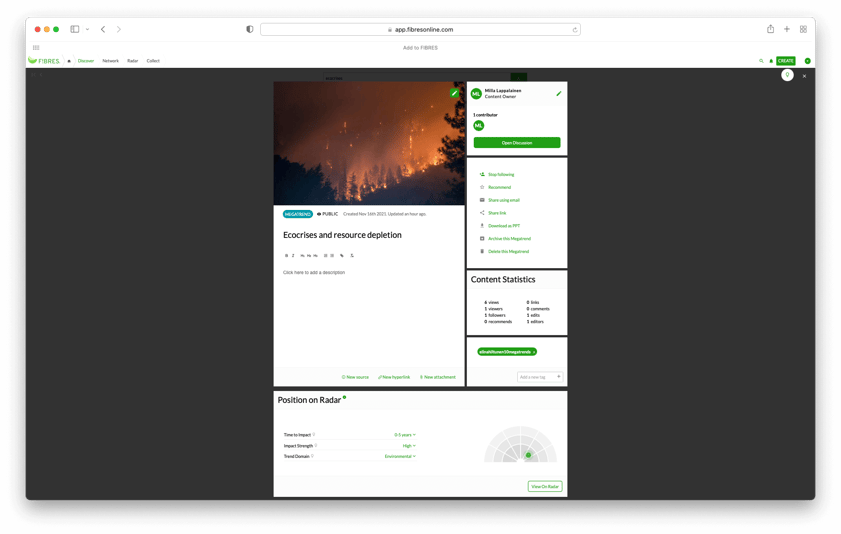
Step 5: Filter your Radar for your megatrends
After positioning your megatrends to the Radar, only one step remains: filtering your Radar to show the recently added megatrends only.
Navigate to the Radar view of FIBRES. Open the filters and select the tag you gave your megatrends as filtering criteria. Once selected, close the filters and select Hide filtered to hide everything else from your Radar.
And that's it – your megatrend Radar is now ready! If you want to include your megatrend radar in a presentation, hit the download button in the bottom right corner to download a .png image of your radar.
You also have the option to configure your FIBRES Account for more than one Radars. In this case, you can skip the step with tagging and filtering altogether.
What our Radar looks like before filtering:
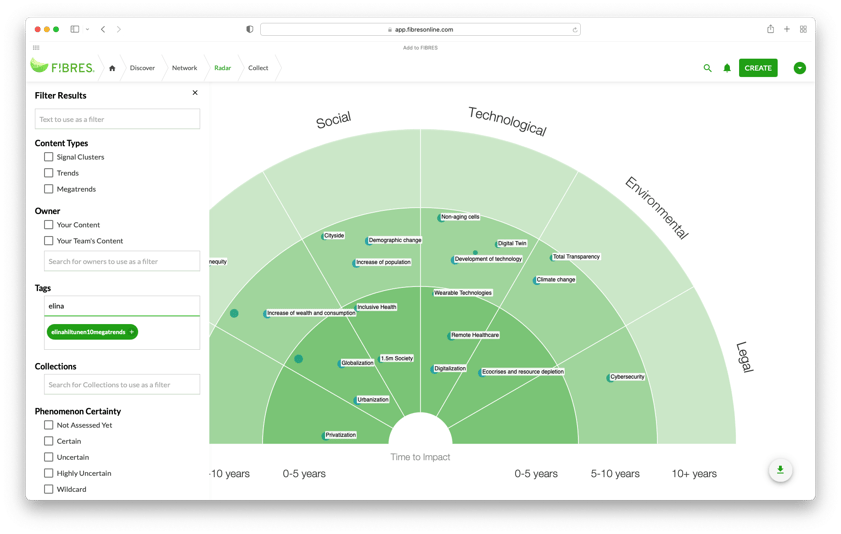
And the same Radar filtered for the tag elinahiltunen10megatrends:
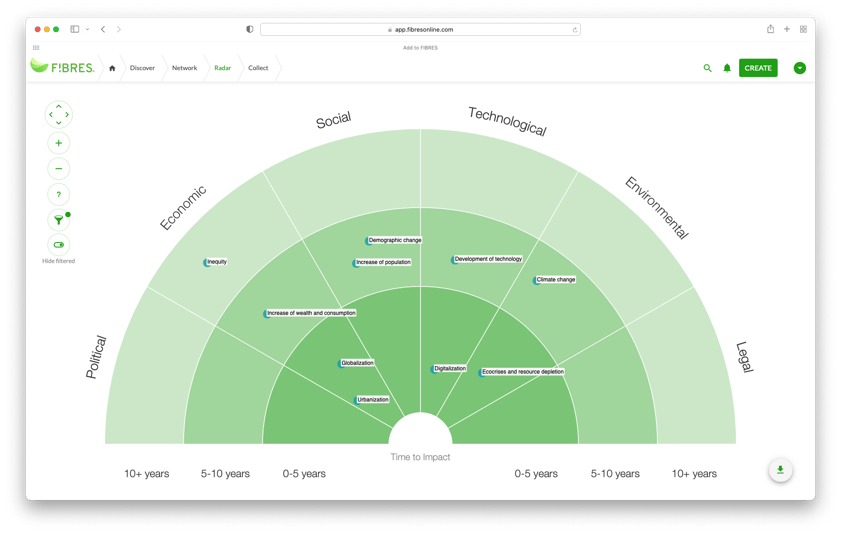
What then? Start building your own understanding
Now that you know how to compile your own megatrend radar (or any radar, for that matter), we can call it a day.
But what outcomes can you expect from this type of exercise? Putting together a trend radar from pre-identified trends can yield interesting discussions when shared with your board, leadership team, or innovation and strategy people.
However, the ultimate goal of any futures intelligence is to create your own understanding that you can use to make decisions in your own business. Creating a megatrend radar can work as a sneaky segway into more profound foresight work in your organization.
So what should you do next? We would recommend making the megatrends yours.
Elina Hiltunen has chosen to only include titles in her megatrend infographic. This can be a blessing in disguise, as it gives you room to think how these megatrends might manifest in your context. What do they mean for your business, for your customers, for your industry?
Expand your megatrends by writing these thoughts in the descriptions. If you have FIBRESEED enabled, FIBRES will recognize the topics you are working on and recommend further content on the topic – and suddenly you have your first horizon scanning process in place.
Take your radars from idea to execution
Check out our vast library of resources for planning your own trend radars for innovation, strategy, and more.
Milla Rogge is head of marketing at FIBRES. She's excited to learn foresight best practices from the top organizations in the world already running their own foresight workflows and to share those learnings with others.
Stay in the loop
Get our latest foresight tips delivered straight to your inbox. You may unsubscribe from these communications at any time.